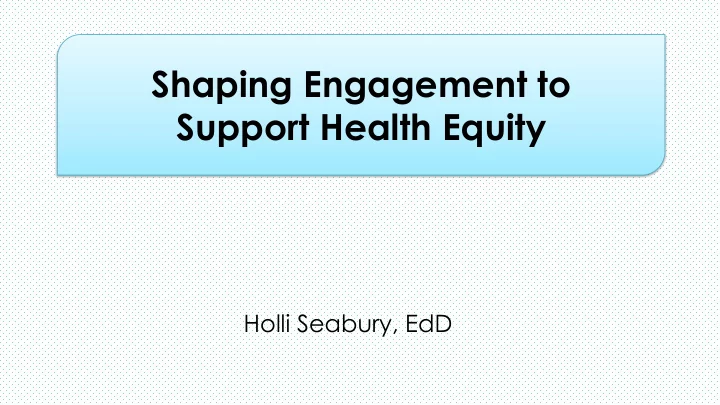

Shaping Engagement to Support Health Equity Holli Seabury, EdD
Social Determinants of Health Social determinants of health are shaped by the distribution of money, power, and resources throughout local communities, nations, and the world. Commission on Social Determinants of Health (CSDH), Closing the gap in a generation: health equity through action on the social determinants of health. Final report of the Commission on Social Determinants of Health. 2008, World Health Organization: Geneva.
Social Determinants of Health Income Gender Education Race Food insecurity Disability Housing Stress Social network Transportation Safety of neighborhood Employment/working conditions Early childhood development Health services
We hold these Truths to be self-evident, that all Men are created equal , that they are endowed by their Creator with certain unalienable Rights, that among these are Life, Liberty, and the Pursuit of Happiness.
Chronic Stress: What are Stressors? Poverty Divorce/Break up Drug/alcohol abuse Poor maternal education Incarceration Job insecurity Mental illness No access to healthcare Food insecurity Transportation insecurity Housing insecurity Physical/emotional abuse Unsafe environment Physical illness
Chronic Stress 60 Mid/High SES 50 % of Children Exposed Low SES 40 30 20 10 5 0 1 2 4 3 “ Children subjected to such stress may lack crucial coping skills and experience significant behavioral and academic problems in school .” Teaching with Poverty in Mind by Eric Jensen
Brain Areas of Known Difference Between Low and Middle-Income Children Source: Adapted from "Neurocognitive Correlates of Socioeconomic Status in Kindergarten Children,” by K. G. Noble, M. F. Norman, and M. J. Farah, 2005, Developmental Science, 8 , pp. 74 – 87.
Source: www.developingchild.harvard.edu
Brain Differences 1.0 0.8 Effect Size 0.6 0.4 0.2 0.0 Visual Language Working Cognitive Reward Memory Spatial Cognition Memory Control Processing Cognition Note: Effect-size differences are measure in standard deviations of separation between low- and middle-income 5-year-olds.
Is linked to over 50 percent of all absences (Johnston- Brooks, Lewis, Evans, & Whalen, 1998). Reduces motivation, determination, and effort (Johnson, 1981). Reduces neurogenesis (growth of new brain cells) (De Bellis et al., 2001). Impairs attention and concentration (Erickson, Drevets, & Schulkin, 2003).
Health Literacy Skills Print Literacy Communication -Reading -Writing -Listening -Numbers -Speaking -Questioning Information Seeking and eHealth -Technology
Nearly 9 out of 10 adults has difficulty using everyday health information.
The 2003 National Assessment of Adult Literacy assessed the English literacy of more than 19,000 adults in the United States.
30 million 95 million 28 million 63 million 14% 29% 44% 13% Intermediate Proficient Below Basic Basic
Below Basic Reading Levels Did not graduate high school 55% No English spoken before starting school 44% Hispanic adults 39% Black adults 20% Age 65+ 26% Multiple Disabilities 21%
Adults living below the poverty level (17% of the adult population) represent 43% of those with below basic health literacy skills.
Situational Stress There are times when even the most literate individuals are not able to process and retain information.
Why “plain language” is not the answer
• Semi-annual shoe stock up event • Buy one get one 50% • All women’s shoes in stores and at target.com
“This form looks like someone took the time to make this and they care about the answers. The other form looks like a test and I don’t know if I will fail.” “It looks more appealing and comfortable.”
So how do we engage?
Clear messages Less words More graphics Video Text messaging
Thank you! Dr. Holli Seabury hseabury@mcmillenhealth.org 260-760-4831
Recommend
More recommend